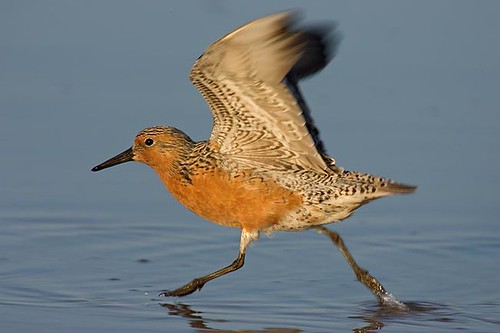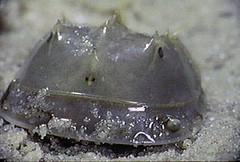
Red knot, Calidris canutus rufus.
This image appears here with the kind permission of the photographer,
Arthur Morris, Birds as Art.
Click image for larger view in its own window.
Ornithologists fear the red knot could go extinct in as few as five years due to overfishing of horseshoe crabs in Delaware Bay, which is the birds' final refueling stop on their 17,000 mile journey to their breeding grounds in the Arctic. Red knots, ruddy turnstones, sanderlings and semipalmated sandpipers all feed on horseshoe crab eggs in the Delaware Bay, and their populations are all experiencing sharp declines.
 However, red knots need to refuel very rapidly during their spring stopover on the Delaware Bay because they fly the longest distances of all these shorebirds and they do so in very short periods of time. Because no other food in the Mid-Atlantic provides the same amount of energy in such a short time, red knots are most severely affected by this decline in horseshoe crab eggs. According to the New Jersey Audubon Society, the red knot population has declined by 54% within the previous two years alone.
However, red knots need to refuel very rapidly during their spring stopover on the Delaware Bay because they fly the longest distances of all these shorebirds and they do so in very short periods of time. Because no other food in the Mid-Atlantic provides the same amount of energy in such a short time, red knots are most severely affected by this decline in horseshoe crab eggs. According to the New Jersey Audubon Society, the red knot population has declined by 54% within the previous two years alone.
This situation transpired after overfishing caused the Atlantic cod fishery to crash in 1992, so fishermen compensated by switching their predaceous attention to the conch fishery. In doing so, fishermen "harvested" millions of horseshoe crabs, Limutus polyphemus (pictured, above right), from Delaware Bay. The horseshoe crab is used as bait to catch conch, which are shipped to Asia, where people devour them. This unregulated fishery depleted the population of horseshoe crabs between 40 percent to 80 percent, according to a research study from Virginia Tech's Horseshoe Crab Research Center.
Despite recent limits enacted on the horseshoe crab take, there are still no signs of a rebound of crabs, crab eggs or shorebirds. Unfortunately, these limits on the catch of horseshoe crabs were not based on any information about the needs of red knots, other migrating shorebirds or even the horseshoe crab.
So what can we do? We must support the alliance of wildlife groups -- including the Defenders of Wildlife, New Jersey Audubon Society, American Bird Conservancy, the National Audubon Society, Delaware Audubon Society, Citizens Campaign for the Environment, Audubon New York, Audubon Maryland-DC and Virginia Audubon Council -- to enact an immediate moratorium on the "harvest" of horseshoe crabs.
This story describes the existing situation well, and it is truly disturbing. After reading that story, you might wonder, is it too late to save the red knot? Not necessarily, as the research shows.

The part of this story that amazes me is that the horseshoe crabs are just being used for bait. One would think that something else could be found as a suitable substitute. Too bad they can't try using Orconectes rusticus (Rusty Crayfish), the invasive species of crayfish that has wreaked havoc on freshwater streams. Maybe someone should set up a job creation program to get people out capturing tons of crayfish in an attempt to clean up the rivers while also providing bait for the conch fishery. I dunno... just seems to me that people haven't been creative enough in finding an alternative to the horseshoe crabs. The crabs are probably just too "convenient" -- much to the detriment of the red knots.